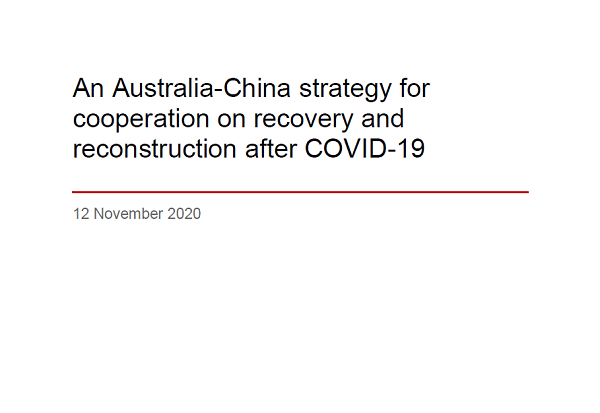An Australia-China strategy for cooperation on recovery and reconstruction after COVID-19
ABER and CCIEE Joint Paper
This is a joint paper from a project of the East Asian Bureau of Economic Research (EABER), in the Crawford School of Public Policy in the College of Asia and the Pacific at The Australian National University funded by a grant from the Australian Government, and China’s Center for International Economic Exchanges (CCIEE), an independent economic think tank funded through the National Development Reform Commission (NDRC) of the Chinese Government. The authors of the paper are Peter Drysdale, Shiro Armstrong, Adam Triggs, Jacob Taylor, Jiao Wang, Will Zou (from EABER) and Yongjun Zhang, Monan Zhang, Yiping Huang, Youwei Yaun, and Xiangdong Liu (from CCIEE).
A key feature of the Australia-China bilateral economic relationship during the global pandemic has been the growth in importance of trade between the two countries. China has recently accounted for as much as 46 per cent of all Australia’s merchandise exports, primarily driven by iron ore and other strategic raw materials as the Chinese market has held firm. That is reflected in strong commodity prices and has cushioned the economic downturn in Australia during the COVID lockdown. Australia’s energy and iron ore exports will help fuel a strong economic recovery in China with low-cost, high-quality inputs into its global supply chains. The relationship is important for the economic recovery of both countries and the Asian region.
The deepening economic interdependence is enormously beneficial to both countries but stands in marked contrast to the deterioration of the bilateral political relationship that has coincided with increased uncertainty in the international political environment. Foreign investment and trade in services — education, tourism and other services — will not automatically revert to pre-pandemic levels without work to repair the fracture in the relationship.
The challenge is to rebuild trust between Australia and China, and in the management of the bilateral relationship. That should be guided by the many shared interests that both countries have in regional and global affairs. A circuit breaker is sensibly the joint pursuit of regional and global efforts to address the health and economic effects of the COVID-19 pandemic. That is the biggest challenge that both countries face in the world today.
The priority areas for cooperation are outlined in this paper. The paper details opportunities for bilateral cooperation between Australia and China with their partners in the region suggested by ABER’s An Asian strategy for recovery and reconstruction after COVID-19. In the aftermath of COVID-19, Australia and China share strong interests in ensuring public health and safety, financial stability and open and rules-based trade in the region. Both governments can contribute towards these goals effectively by working actively together in multilateral settings such as the ASEAN+6 grouping, EAS, APEC and the G20.


